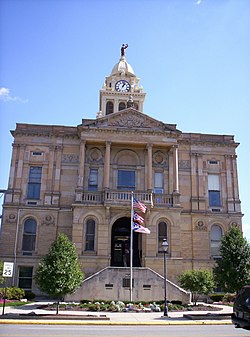2010 census
As of the 2010 United States census, there were 66,501 people, 24,691 households, and 16,837 families living in the county. [19] The population density was 164.7 inhabitants per square mile (63.6/km2). There were 27,834 housing units at an average density of 68.9 units per square mile (26.6 units/km2). [20] The racial makeup of the county was 91.1% white, 5.7% black or African American, 0.5% Asian, 0.2% American Indian, 0.1% Pacific islander, 0.8% from other races, and 1.7% from two or more races. Those of Hispanic or Latino origin made up 2.3% of the population. [19] In terms of ancestry, 29.7% were German, 15.2% were Irish, 14.7% were American, and 10.2% were English. [21]
Of the 24,691 households, 31.8% had children under the age of 18 living with them, 49.4% were married couples living together, 13.3% had a female householder with no husband present, 31.8% were non-families, and 26.3% of all households were made up of individuals. The average household size was 2.47 and the average family size was 2.94. The median age was 39.9 years. [19]
The median income for a household in the county was $40,511 and the median income for a family was $50,900. Males had a median income of $39,741 versus $30,161 for females. The per capita income for the county was $19,849. About 13.1% of families and 17.3% of the population were below the poverty line, including 24.6% of those under age 18 and 9.4% of those age 65 or over. [22]
2000 census
As of the census [23] of 2000, there were 66,217 people, 24,578 households, and 17,253 families living in the county. The population density was 164 inhabitants per square mile (63/km2). There were 26,298 housing units at an average density of 65 units per square mile (25/km2). The racial makeup of the county was 92.10% White, 5.75% Black or African American, 0.19% Native American, 0.52% Asian, 0.01% Pacific Islander, 0.49% from other races, and 0.95% from two or more races. 1.09% of the population were Hispanic or Latino of any race.
There were 24,578 households, out of which 32.30% had children under the age of 18 living with them, 54.50% were married couples living together, 11.40% had a female householder with no husband present, and 29.80% were non-families. 25.10% of all households were made up of individuals, and 10.90% had someone living alone who was 65 years of age or older. The average household size was 2.50 and the average family size was 2.98.
In the county, the population was spread out, with 24.50% under the age of 18, 8.30% from 18 to 24, 30.30% from 25 to 44, 23.50% from 45 to 64, and 13.40% who were 65 years of age or older. The median age was 37 years. For every 100 females there were 106.90 males. For every 100 females age 18 and over, there were 107.10 males.
The median income for a household in the county was $38,709, and the median income for a family was $45,297. Males had a median income of $33,179 versus $23,586 for females. The per capita income for the county was $18,255. About 7.40% of families and 9.70% of the population were below the poverty line, including 13.60% of those under age 18 and 5.50% of those age 65 or over.





